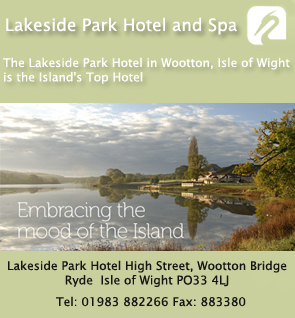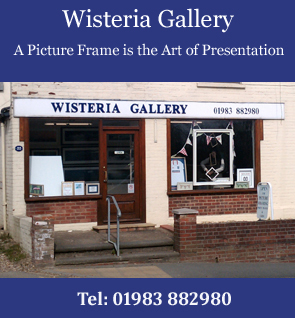Arreton
Church of St. George
Is one of the six Island churches bestowed by William Fitz Osbern on his Norman abbey of Lire. It is mentioned in Domesday, (fn. 184) so must have been built before 1086, the original structure being of the early aisleless type with a square west end, and probably an apsidal eastern termination. Evidence of this early work is to be found in the central openings in the west wall—the window without reveal groove or rebate, the door opening (fn. 185) with its long and short quoins—and the narrow deeply splayed round-headed light over the priest's door in the chancel. This simple rectangular plan was maintained till the rectory was given about 1150 to the abbey of Quarr (see below).

Henceforth the church was cared for by the Island monks, who at once set about enlarging the structure, the first addition—the north aisle with its Romanesque capitals (fn. 186) and single splayed arches—being made during the first twenty years of their ownership. Then early in the next century the south aisle was added, (fn. 187) and to compensate for the removal of the side windows the present long lancets were inserted in the west wall. (fn. 188) The confirmation in 1289 of the early settlement between the Abbots of Quarr and Lire as to the endowment of Arreton Church may have given additional stimulus to the building operations already begun, resulting in the two chancels (fn. 189) with their beautiful connecting arcade. Two eastern windows of three lights and five side windows of two lights, two in the north and three in the south wall light these. (fn. 190) There was also a small plate-traceried window (fn. 191) in the west wall, now blocked by the later aisle roof.
The original chancel walls were fully polychromed, as is evidenced by the splays of the early single light over the priest's door in the north wall which was blocked up in the chancel rebuilding, and a tempera painting of the Last Judgement, (fn. 192) 9 ft. high by 7 ft. wide, inclosed within a foliated border 9½ in. wide, painted on the wall space thus gained. The new work was linked up to the old by the insertion of a somewhat clumsy arch in the east wall of the south aisle; finally a tower was built at the west end, and to compensate for the blocking of the western lights quatrefoil clearstory openings were made over the nave arcades north and south. For upwards of two hundred years little or nothing was done to the church, but towards the close of the 15th century— circa 1480—the upper stage of the tower was rebuilt and the huge angle buttresses added as a greater security to the structure. A rood screen was at this period erected across the chancel arch—the entrance to which is still visible with a piscina for the altar under—a south window inserted to light it, and the opening, probably for the sanctus bell, made over the chancel arch. A nave with clearstory, north and south aisles with lean-to roof pitching under the clearstory lights, (fn. 193) a western tower, north and south chancels, an oaken screen with groined rood-loft and, from existing evidence, four altars for service: such was Arreton Church at the opening of the 16th century, which is responsible for the raising of the aisle walls, the insertion of Tudor windows, the addition of a south porch (fn. 194) and the present roof with its one vast ugly slope, blocking the clearstory and destroying its raison d'être. (fn. 195) Post-Reformation work is now conspicuous by its absence. Except the memorial tablets there is little evidence of its existence and the churchwardens' accounts now become our authority. In 1649 the bells were rehung and the roof repaired, which latter in 1738 was further ceiled with plaster. In 1742 the present weathercock was set on the tower, and two years later the linen panelled benches began to give place to the family pew. In 1748 the porch was covered with lead, and in 1752 a new oak pulpit was placed in the church at a cost of £21 2s. 8d. In 1863 a 'restoration' (fn. 196) took place, which was completed in 1886, when the Worsley Holmes chapel at the west end of the south aisle was removed, all vestiges of pewing (fn. 197) swept away and the church reseated and 'tidied up.' At the latter date shattered remains of the 13th-century font were brought to light as well as some fragments of sculpture now fixed in the east wall of the north aisle. The latter are excellent work of the period of the rebuilding of the chancel, and represent a dragon's head in freestone with traces of colour and a draped figure inclosed in a quatrefoil in Purbeck stone. There is a trefoiled piscina niche by the side of the loft opening, evidence of the former existence of a nave altar here against the screen. At the east end of the chancel north wall is an ancient aumbry, (fn. 198) and opposite it an original piscina, while in the sill of the easternmost window of the south chancel is a piscina bowl of quatrefoil form. The recess below the east window of the south chancel may have been for an Easter Sepulchre. The font is modern, based on the motif of the remains found at the 1886 restoration. The only pictorial brass is to Harry Hawles, steward of the Isle of Wight under the non-resident lords succeeding the Earl of Salisbury. The figure, which is 30 in. high, is clad in the plate armour of the period, circa 1420, but the head, shield (fn. 199) and sword hilt are missing. The feet rest on a lion with the rhyming epitaph in black letter: —
HERE IS Y BYRIED UNDER THIS GRAVE
HARRY HAWLES HIS SOUL GOD SAVE
LONGE TYME STEWARD OF THE YLE OF WYGHT
HAVE M'RCY ON HYM GOD FUL OF MYGHT.
Another rhyming epitaph is to William Serle of Stone, who died in 1595. The 17th-century records include Edward Fayrebrace, vicar 1615, Thomas Lisle of Briddlesford 1621, Edward Harbert of Birchmore 1628 and David Wavil 1629. The 18th-century memorials to William Griffin vicar 1732, William Ruffin of Birchmore 1757 and later tablets to the Roberts (fn. 200) family of West Standen and the Bells of Stickworth bring us to the more pretentious sculptured monuments now in the south aisle, to the memory of Richard Fleming Worsley-Holmes, drowned while boating in the Hamble River in 1814, and Sir Leonard Worsley Holmes, bart., 1825, the work respectively of Westmacott and a local artist named Haskoll. The original of Legh Richmond's 'dairyman's daughter,' Elizabeth Wallbridge, is buried in the churchyard. There is a copy in a case in the south chancel of Foxe's Actes and Monuments (ed. 9 in 3 vols.). There are also in the south chancel a Jacobean altar table and an oak chest dated 1679 with the initials of the churchwardens, W. H. and B. R.
There are four ancient bells, the oldest of the 15th – 16th century inscribed in black letter 'Ihus Nicholaus Serle et Alicia ux' ejus fec' fi'me.' (fn. 201) The others 'Anno 1559,' 'In God is my hope, R.B. 1601.' (fn. 202) 'William Griffin vicor, Geo. Oglander, Henry Bull Churchwardens, Clemant Tosiear cast mee in the year of 1699.' The fifth and sixth are modern bells by Mears & Stainbank, 1896. The church plate consists of an Elizabethan chalice and cover, date 1566–7, a flagon 1861–2, and a small salver 1732–3.
The registers date from 1653 and are contained in five books: (i) burials 1653 (fn. 203) to 1735; (ii) baptisms and burials 1742 to 1797, marriages 1742 to 1753; (iii) baptisms and burials 1797 to 1812; (iv) and (v) marriages 1754 to 1812. The churchwardens' accounts begin in the 17th century and are in three books: (i) 1706 to 1783; (ii) 1724 to 1769; (iii) 1768 to 1843. The first book (17th century) is missing and is said to have been destroyed.
ADVOWSON
The church of Arreton was held in 1086 by the abbey of Lire. (fn. 204) About 1150 an agreement was made and confirmed in 1289 by which, in exchange for a pension of 40s., the Abbot of Lire conceded to the Abbot of Quarr the tithes of Arreton, (fn. 205) but the advowson was reserved to the Abbot of Lire and belonged to his successors (fn. 206) until 1400, when it was given to the abbey of Quarr. (fn. 207) In 1405 the church was appropriated to the abbey of Quarr, and in return for this appropriation the abbot undertook to pay a pension of 10s. yearly to the Bishop of Winchester. (fn. 208) The advowson and rectory remained with Quarr Abbey until the Dissolution, (fn. 209) when they passed to the Crown. They were granted in 1549 to George Mill, (fn. 210) whose nephew and heir Richard sold them in 1609 to Sir Thomas Fleming, (fn. 211) Lord Chief Justice of England, with whose descendants the presentation still remains. (fn. 212)
There was a chapel at Briddlesford dedicated to St. Martin, which is entered in the Dean's return of 1305 as being endowed with the great and small tithes of the demesne of John de Lisle at Briddlesford. (fn. 213) The advowson belonged to the lords of the manor. (fn. 214) At the Reformation it was returned that this chapel had been founded by the ancestors of Sir Thomas Lisle, but that at that time no divine service was celebrated there. (fn. 215) The advowson of the chapel was still numbered among the possessions of the lords of the manor in the 16th and 17th centuries, (fn. 216) and in 1775 the site of the late dissolved free chapel of St. Martin in Briddlesford is mentioned in a conveyance of the manor. (fn. 217) It had entirely disappeared before 1795, but still continued to pay a rent of £1 8s. 4d. to the Crown at that time. (fn. 218) In 1380 a chaplain was presented by the king, as guardian of the heir of Sir Thomas Lisle, to the chantry of St. Nicholas in the church of Briddlesford, but this seems to have been the same as the free chapel. (fn. 219)
Sources:
184 V.C.H. Hants, i, 457.
185 This has no rebate for door and may have been originally covered by a west porch.
186 The easternmost column has a scallop capital, the others having the corner splayed abacus springing direct from the circular neck.
187 Evidence of the addition of these aisles is the straight joint still visible on either side of the tower.
188 These were opened in 1886 by cutting away the north and south walls of the tower.
189 The rectorial chancel is maintained by the Flemings as owners of the Quarr lands, the vicarial is kept up by a charge on Pyle Farm in the parish of Chale.
190 Some of the original grisaille glass still remains in situ.
191 This looks earlier and may have come from elsewhere.
192 This was practically destroyed in the 1863 restoration when the early single light was opened out.
193 Evidence of this is the stone weathering remaining in parts under the clearstory lights and over the arch at the east end of the south aisle.
194 This form of porch with its stone ribs supporting the roof is not uncommon in the Isle of Wight, being found at Whitwell and Niton.
195 To compensate for covering in the rood-loft window a gablet light was made in the roof.
196 It was at this time that a way was cut through to the pulpit, one concludes to match the opposite entrance to the rood-loft.
197 Some of the linen panels still remained and were used for various purposes.
198 This has a curious 'cache'— presumably for the chalice—cut in the sill stone about 9 in. square and 5 in. deep.
199 Charged with three wolves' heads, Sir John Oglander notes wrongly. Hawles' arms were sable three talbots' heads razed argent.
200 John Roberts, 1741. Edward Roberts, R.N., 1810. Edward Roberts, R.N., 1831.
201 This may be later and the gift of the first Serle holder of Stone, temp. Henry VIII, but the lettering looks earlier, though old stamps may have been used in the casting.
202 Probably one of the Bonds' bells.
203 First legible entry is 29 Sept. 1653, as the first eight pages are practically destroyed and the next four badly mutilated.
204 V.C.H. Hants, i, 457.
205 Ibid. ii, 138; Worsley, op. cit. App. no. 70; Dugdale, Mon. Angl. v, 318.
206 Carisbrooke Chart. iii, vi; Egerton MS. 2031, fol. 3; Cal. Pat. 1317–21, pp. 125, 134, 142; 1340–3, pp. 283, 348; 1350–4, p. 40; 1381–5, p. 106; 1388–92, p. 103; Cal. Papal Letters, ii, 285–6; Wykeham's Reg. (Hants Rec. Soc.), i, 208,
207 Cal. Pat. 1399–1401, p. 221.
208 Egerton MS. 2034, fol. 32 d.; Worsley, op. cit. App. no. 78.
209 Valor Eccl. (Rec. Com.), ii, 24.
210 Pat. 3 Edw. VI, pt. v, m. 10.
211 Feet of F. Hants, East. 7 Jas. I.
212 Inst. Bks. (P.R.O.).
213 Worsley MS. penes Mr.F.M. Nichols, F.S.A.
214 Chan. Inq. p.m. 19 Edw. III (1st nos.), no. 52; Egerton MSS. 2033, fol. 6 d.; 2034, fol. 160.
215 Aug. Off. Chant. Cert. 51, no. 2.
216 Chan. Inq. p.m. (Ser. 2), cxxxvii, 46; cclxxxiii, 97.
217 Feet of F. Hants, Hil. 15 Geo. III.
218 Albin, op. cit. 538.
219 Wykeham's Reg. (Hants Rec. Soc.), i, 108, 147.
From: 'Parishes: Arreton', A History of the County of Hampshire: Volume 5 (1912), pp. 139-151.
Links:
http://www.british-history.ac.uk/report.aspx?compid=42063 ![]()










 Help To Support Us
Help To Support Us





 Our Facebook page
Our Facebook page Get the latest Tweets
Get the latest Tweets You Tube
You Tube RSS Feed
RSS Feed
